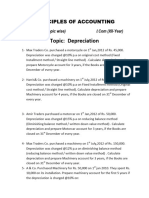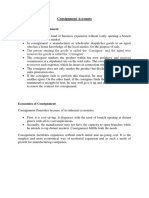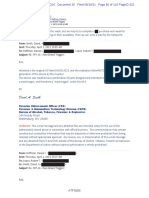Unit 2 Exam Questions and Problems
Unit 2 Exam Questions and Problems
Uploaded by
kartikgmohotaCopyright:
Available Formats
Unit 2 Exam Questions and Problems
Unit 2 Exam Questions and Problems
Uploaded by
kartikgmohotaOriginal Title
Copyright
Available Formats
Share this document
Did you find this document useful?
Is this content inappropriate?
Copyright:
Available Formats
Unit 2 Exam Questions and Problems
Unit 2 Exam Questions and Problems
Uploaded by
kartikgmohotaCopyright:
Available Formats
G. VENUGOPAL, Faculty, Department of Commerce, VVN Degree College, VV Puram, Bangalore -04.
Unit – 2. Consignment Accounts.
Examination Questions and Answers Two Marks:
1. What is Consignment? June-2013, May-2016
Ans. Consignment is an agreement under which a manufacturer or a wholesaler
sends goods to his agent for the purpose of sale on his behalf and at his own risk
on commission basis. Consignment refers to sending of goods by a principal to his
agent, who sells the goods on behalf of the principal in return for a commission.
2. What is an Account Sales? June-2013, June-2018
Give the meaning of Account Sales. June -2014
Ans. The consignee informs the consignor periodically about the volume and value
of sales effected and also the expenses incurred by him through a statement called
‘Account Sales’. The account sales contains gross sale proceeds, the selling
expenses incurred by consignee and the commission payable to him and also the
method of settlement of balance due to the consignor.
3. What is Normal Loss in Consignment? How it is treated? June-2013
Ans. When goods are lost or damaged due to normally expected but unavoidable
causes such as evaporation, leakage, breakage, dusting or weighment etc. Such
loss is called Normal Loss.
It is inherent and cannot be avoided and increases the cost of goods. It is treated
as part of the cost and the cost of unsold goods increases proportionately due to
such loss.
4. Who is Consignor? June-2014, May-2015
Ans. The person sending the goods on consignment to another person is called
consignor (Principal).
5. What is over-riding commission? June-2014, May-2016
Ans. An extra commission over and above ordinary commission is given by the
consignor to the consignee for working hard to push a new line of product in the
market. Such commission is called Overriding Commission.
6. What is Del-credere commission? May-2015, May-2019
Ans. It is a commission which is paid by the consignor to the consignee for taking
additional risk of recovery of debts due from customers to whom the goods have
been sold on credit.
GV. VVNDC Page 1
G. VENUGOPAL, Faculty, Department of Commerce, VVN Degree College, VV Puram, Bangalore -04.
7. Give the meaning and examples for non-recurring expenses in consignment
accounts. May-2017
Ans. All the expenses which are incurred for bringing goods to the godown of the
consignee are called non-recurring expenses. The consignor usually incurs
expenses on sending the goods to the consignee such as packing, carriage,
loading charges, freight, insurance etc. The consignee incurs expenses on
receiving the goods from the consignor such as dock dues, customs duty, clearing
charges, Carriage etc. These expenses are called as non-recurring expenses.
8. Who is consignee and consignor? May-2017
Ans. The person to whom the goods are sent on consignment is called the
consignee and the person sending the goods on consignment is called the
consignor.
9. If the value of goods sent on consignment is Rs.1,20,000, sent at 20% load
on cost, find out the cost of goods sent. May-2019.
Ans. If cost is 100 Load is 20. So Sale is 120 (value of goods sent)
If Sale is Rs.1,20,000 Cost = 1,20,000x100/120 = 1,00,000.
GV. VVNDC Page 2
G. VENUGOPAL, Faculty, Department of Commerce, VVN Degree College, VV Puram, Bangalore -04.
Unit – 2. Consignment Accounts: Examination Problems:
May/June – 2013
Problem – 1. (8 Marks)
Ravi of Bangalore sent a consignment of 2,000 articles to his agent Sridhar of Kolar at
Rs.20 per article. Railway charges, cartage and insurance amounted to 10% of total
cost of goods. Sridhar sold 2,000 articles at Rs.30 each and sent an account sales
enclosing a bank draft for the balance after deducting
a) His advance of Rs.5,000
b) His expenses Rs.500 and
c) His commission at 10% of Gross sales.
Pass the necessary Journal Entries in the books of Ravi of Bangalore.
Problem – 2. (16 Marks) Repeated in May -19 (without the bill drawn Rs.20,00,000
as advance transaction)
Amco Batteries Ltd. Bangalore consigned 1,500 Batteries costing Rs.5,000 each, to
Manju Electricals of Mulbagal. The consignor paid Rs.75,000 towards Freight charges
and insurance Rs.30,000. During transit it was found that 10 Batteries were damaged
and insurance company settled the claim for Rs.45,000. Manju Electricals received the
balance consigned goods and paid unloading charges Rs.14,900. They accepted a bill
drawn for Rs.20,00,000 as advance. Manju Electricals sold 800 Batteries for cash at
Rs.6,500 and 450 Batteries on credit at Rs.7,000 each. They spent Rs.42,000 for
Godown Rent, Rs.6,500 for advertisement and Rs.30,000 as salesmen salary. The
consignee entitled to get an ordinary commission at 5% on sales and Del credere
commission at 2% on credit sales. Manju Electricals remit the balance due to the
consignor by bank draft.
Prepare (a) Consignment A/c (b) Consignee A/c (c) Abnormal Loss A/c.
May/June – 2014
Problem – 3. (8 Marks)
Bhaskar consigns 1,200 units of a product costing Rs.300 each to Chandan. He incurs
Rs.6,000 for carriage expenses. 60 units of the product are stolen in transit. Chandan
receives the remaining goods, and sells 1,020 units at Rs.460 per unit. Expenses
incurred by him amounted to Rs.4,260, the entire amount being non-recurring. He
reports a normal loss of 24 units. Find the value of abnormal loss and closing stock.
Problem – 4. (16 Marks)
Hamsa sends 70,000 units of a product at Rs.40 each to Indira on consignment basis
and incurs Rs.16,000 on freight and Rs.14,500 on agents commission. On receipt of
goods Indira accepts a bill drawn by Hamsa for Rs.6,00,000 for 3 months and at the
end of the accounting year, she sends account sales showing the following details:
Sales – 60,000 units at an average price of Rs.58 each.
Normal loss – 2% of the goods consigned.
Expenses incurred – unloading charges Rs.14,000; Carriage inwards Rs.15,000;
Carriage outwards Rs.12,500 and Godown Rent Rs.13,500.
Indira is entitled for a commission of 5% on total sales. The final balance due to
Hamsa is settled by Bank Draft.
Pass journal entries and prepare necessary ledger accounts in the books of Hamsa.
GV. VVNDC Page 3
G. VENUGOPAL, Faculty, Department of Commerce, VVN Degree College, VV Puram, Bangalore -04.
April/May – 2015
Problem – 5. (6 Marks)
Lokesh of Mysore sends 2000 kgs of oil at Rs.120 per Kg to Nataraj at Hubli. The
consignor spends Rs.11,000 on cartage, insurance and freight. On the way 100 Kgs of
oil was lost (normal loss) due to leakage and evaporation. Nataraj took delivery of the
consignment and spent Rs.9,000 on octroi and carriage. His selling expenses were
Rs.7,000 on 1700 Kg’s of oil sold. Determine the value of stock.
Problem – 6. (14 Marks)
M/s Raghu and Co. of Delhi consigned on 15 th March 2012, 45 cases of glass at cost
price Rs.45,000 to Reddy and Co. Hyderabad for sale on commission at 5% on gross
sale proceeds. The consignor paid freight and carriage amounting to Rs.539.
The goods arrived at Hyderabad on 20 th March 2012, Reddy and Co. paid
clearing charges Rs.235, sundry charges Rs.59, carriage Rs.102 and godown charges
Rs.90.
The goods were sold by Reddy and Co. as under
15 cases at Rs.1,000 per case. 22 cases at Rs.1,050 per case and the remaining 8
cases at Rs.1,250 per case.
On June 21, 2012 Reddy and Co. sent a draft for Rs.10,000 to M/s Raghu and
Co. on account. On 1st July 2012, Reddy and Co. forwarded an account sale together
with a bill of exchange for the balance.
Give Journal entries to record the above transactions in the books of consignor
and consignee. Calculations are to be made to the nearest Rupee.
May – 2016
Problem – 7. (6 Marks)
Mr. Nandish of Mysore, consigned 500 kgs. of oil @ Rs.30 per kg. to Mr. Satish. He
paid Rs.4,000 as carriage and freight charges.
Mr. Satish also paid Rs.1,000 towards unloading charges, Rs.2,000 as godown
rent and Rs.1,500 as selling expenses. Normal loss due to leakage is 40 kgs. of oil in
transit. Satish sold 320 kgs. of oil @ Rs.55 per kg. and 19 kgs. of oil @ Rs.60 per kg.
Calculate value of unsold stock.
Problem – 8. (14 Marks)
M/s Sagar and company consigned 1500 tins costing Rs.600 per tin to their agent
Manohar Stores, Kolkata. The tins were invoiced at proforma price of Rs.800 per tin.
The agent sold 900 tins at Rs.810 per tin for cash, 400 tins at Rs.850 on credit. The
Sagar and Co. paid Rs.5,000 as freight and Rs.2,000 as insurance. They drew a bill
on Manohar stores at 3 months for Rs.6,00,000 which was duly accepted by the latter.
The expenses incurred by the Manohar stores were carriage Rs.500, Octroi Rs.1,500
and storage rent Rs.1,100. They were entitled to 5% commission and 2% del-credere
commission on total sales. They sent their account sales to their principal showing as
a deduction there from their commission and the various expenses incurred by them.
Prepare necessary ledger accounts in the books of M/s Sagar and Co.
GV. VVNDC Page 4
G. VENUGOPAL, Faculty, Department of Commerce, VVN Degree College, VV Puram, Bangalore -04.
May – 2017
Problem – 9. (6 Marks)
Krishna Murthy of Bengaluru sent a consignment of 2,000 articles to his agent Sri
Raghavan of Tumkur at an invoice price of Rs.20 per article. Railway charges, cartage
and insurance amounted to 10% of the total invoice price.
Raghavan sold 1,500 articles at Rs.30 each and sent an account sales enclosing a
bank draft for the balance after deducting i) his advance of Rs.5,000, ii) his expenses
Rs.500 and iii) his commission at 10% on gross sales. 100 articles were lost in transit
and the insurance company admitted the claim for Rs.1,100.
Show the Consignment Account and Consignee’s Account in the books of the
Consignor.
Problem – 10. (14 Marks)
Madan of Bengaluru consigns goods to Swamy of davangere to be sold at or above
invoice price. Swamy is to get 10% commission on sales at invoice price plus 20% of
any surplus price realized. Madan draws on Swamy at 60 days bill for 80% of the
invoice price the balance of the proceeds being remitted by the bank draft by Swamy
after deduction of his commission immediately upon sale.
On 1st January 2016 Madan consigned goods whose total cost including freight was
Rs.1,50,000 the invoice price of which was Rs.2,25,000. Sales by Swamy by 30 th June
2016 amounted to Rs.2,05,000. Goods unsold on 30 th June 2016 with Swamy were of
invoice price Rs.67,500, (cost including freight Rs.45,000). On 30 th June 2016 Madan
had received from Swamy by the bank draft Rs.49,750, certain remittances being in
transit on 30th June 2016.
Show the Ledger A/c’s in the books of Madan recording the above transactions.
May – 2018
Problem – 11 (6 Marks)
Calculate the value of abnormal loss and value of closing stock from the following
information:
a) Goods sent on consignment – 400 units of glassware at Rs.100/- per unit.
b) Expenses incurred by the consignor – Rs.2,000.
c) Goods lost in transit – 20 units.
d) Expenses incurred by the consignee – taxes Rs.1,420 and selling expenses
Rs.1,000.
e) Goods sold by the consignee – 340 units.
f) Goods damaged at Consignee’s place – 2% of the total goods consigned
(which is permissible).
GV. VVNDC Page 5
You might also like
- The Qanun-e-Shahadat Order, 1984 (X of 1984)100% (2)The Qanun-e-Shahadat Order, 1984 (X of 1984)54 pages
- 747102036-Consignment CPT Notes 19 SeptNo ratings yet747102036-Consignment CPT Notes 19 Sept15 pages
- 12 Advanced Financial Accounting – Sep 2020 (CBCS – F+R 2014-15 and onwards)No ratings yet12 Advanced Financial Accounting – Sep 2020 (CBCS – F+R 2014-15 and onwards)6 pages
- Consignment Accounts by Prof. Bharat GuptaNo ratings yetConsignment Accounts by Prof. Bharat Gupta9 pages
- Consignment and Joint Venture Question and Solution100% (1)Consignment and Joint Venture Question and Solution4 pages
- Bachelor of Commerce: Bcoc - 131: Financial AccountingNo ratings yetBachelor of Commerce: Bcoc - 131: Financial Accounting4 pages
- VIS_Class11_Annual.Paper.Accountancy__23-24_ (1)No ratings yetVIS_Class11_Annual.Paper.Accountancy__23-24_ (1)6 pages
- KVS Mumbai XI ACC SQP & SMS SET-II (Annual Exam) (22-23)No ratings yetKVS Mumbai XI ACC SQP & SMS SET-II (Annual Exam) (22-23)23 pages
- Indirect Tax Laws Test 1 3 2 May 2024 Test Paper 1706264983No ratings yetIndirect Tax Laws Test 1 3 2 May 2024 Test Paper 170626498311 pages
- PGDM 2012-2014 ONLINE QUIZ Divisions A, B & C Domes 1, 2 & 3 Course Name: Management AccountingNo ratings yetPGDM 2012-2014 ONLINE QUIZ Divisions A, B & C Domes 1, 2 & 3 Course Name: Management Accounting5 pages
- 1735630012495_Revision_worksheet_for_accounts (3)No ratings yet1735630012495_Revision_worksheet_for_accounts (3)4 pages
- Test Series: August, 2018 Foundation Course Mock Test Paper - 1 Paper - 1: Principles and Practice of Accounting (Time Allowed: 3 Hours) (100 Marks)No ratings yetTest Series: August, 2018 Foundation Course Mock Test Paper - 1 Paper - 1: Principles and Practice of Accounting (Time Allowed: 3 Hours) (100 Marks)118 pages
- Azerbaijan: Moving Toward More Diversified, Resilient, and Inclusive DevelopmentFrom EverandAzerbaijan: Moving Toward More Diversified, Resilient, and Inclusive DevelopmentNo ratings yet
- GST Implementation Detailed Document For Consultant100% (1)GST Implementation Detailed Document For Consultant9 pages
- Form For Change of Name in Demat Account - FinalNo ratings yetForm For Change of Name in Demat Account - Final1 page
- LORENZO Vs POSADAS G.R. No. L-43082 June 18, 1937100% (3)LORENZO Vs POSADAS G.R. No. L-43082 June 18, 19373 pages
- Republic of The Philippines Baguio City en BancNo ratings yetRepublic of The Philippines Baguio City en Banc188 pages
- A. Ocampo - The Fight Over The Rizal LawNo ratings yetA. Ocampo - The Fight Over The Rizal Law2 pages
- Technical Document Requirements For NoBos Ver 2.0No ratings yetTechnical Document Requirements For NoBos Ver 2.072 pages
- King County Urban Growth Capacity Final Draft Report - June 2021No ratings yetKing County Urban Growth Capacity Final Draft Report - June 2021409 pages
- Whistleblo Wing: Here Starts The Lesson!No ratings yetWhistleblo Wing: Here Starts The Lesson!15 pages
- Reckley (No 2) and The Prerogative of Mercy: Act Of: Grace or Constitutional Safeguard?No ratings yetReckley (No 2) and The Prerogative of Mercy: Act Of: Grace or Constitutional Safeguard?11 pages
- LAW 116 - Reyes v. Reyes (A.M. No. MTJ-06-1623)100% (1)LAW 116 - Reyes v. Reyes (A.M. No. MTJ-06-1623)2 pages
- 12 Advanced Financial Accounting – Sep 2020 (CBCS – F+R 2014-15 and onwards)12 Advanced Financial Accounting – Sep 2020 (CBCS – F+R 2014-15 and onwards)
- Consignment and Joint Venture Question and SolutionConsignment and Joint Venture Question and Solution
- Bachelor of Commerce: Bcoc - 131: Financial AccountingBachelor of Commerce: Bcoc - 131: Financial Accounting
- KVS Mumbai XI ACC SQP & SMS SET-II (Annual Exam) (22-23)KVS Mumbai XI ACC SQP & SMS SET-II (Annual Exam) (22-23)
- Indirect Tax Laws Test 1 3 2 May 2024 Test Paper 1706264983Indirect Tax Laws Test 1 3 2 May 2024 Test Paper 1706264983
- PGDM 2012-2014 ONLINE QUIZ Divisions A, B & C Domes 1, 2 & 3 Course Name: Management AccountingPGDM 2012-2014 ONLINE QUIZ Divisions A, B & C Domes 1, 2 & 3 Course Name: Management Accounting
- Test Series: August, 2018 Foundation Course Mock Test Paper - 1 Paper - 1: Principles and Practice of Accounting (Time Allowed: 3 Hours) (100 Marks)Test Series: August, 2018 Foundation Course Mock Test Paper - 1 Paper - 1: Principles and Practice of Accounting (Time Allowed: 3 Hours) (100 Marks)
- Azerbaijan: Moving Toward More Diversified, Resilient, and Inclusive DevelopmentFrom EverandAzerbaijan: Moving Toward More Diversified, Resilient, and Inclusive Development
- GST Implementation Detailed Document For ConsultantGST Implementation Detailed Document For Consultant
- King County Urban Growth Capacity Final Draft Report - June 2021King County Urban Growth Capacity Final Draft Report - June 2021
- Reckley (No 2) and The Prerogative of Mercy: Act Of: Grace or Constitutional Safeguard?Reckley (No 2) and The Prerogative of Mercy: Act Of: Grace or Constitutional Safeguard?

























































































